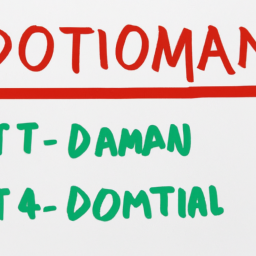Comparing Domain Authority vs Domain Rating - Exploring the Differences
Domain Authority vs Domain Rating
Domain Authority vs Domain Rating: A Primer
We may often hear the terms 'Domain Authority' and 'Domain Rating', but what do these terms mean? It is important to understand the subtle differences between Domain Authority and Domain Rating to maximise our website's online performance. With this in mind, let's kickstart our prelude with an enlightening introduction to Domain Authority and Domain Rating, and strive to enrich our understanding of these two important industry terms.
The primary area of our discussion centres around Domain Authority (DA) and Domain Rating (DR). It is important to note that both Domain Authority and Domain Rating are used to analyse the strength of a website. Accordingly, we shall proceed to pinpoint 8 to 12 chief points, offering a swift snapshot for each.
Domain Authority
Domain Authority (DA) was developed in 2007 by Moz, an SEO software company. DA is a predictive measure of how likely a domain is to rank on search engine results pages, and it uses a logarithmic scale from 0-100. DA shows the overall effectiveness of the domain's content, links and other features to rank on SERPs. DA is fluid and can increase or decrease over time.
How is Domain Authority Calculated?
The complexity of Moz's DA algorithm is shrouded in secrecy, but as a general overview, the authority of a domain is based on a variety of factors. These factors include analysis of inbound links from other domains, the total number of pages and linking root domains, MozRank, MozTrust, and other metrics.
Domain Rating
Domain Rating (DR) is Ahrefs' version of DA. Developed by Ahrefs in 2013, DR operates on a logarithmic scale from 0-100. It quickly emerged as an industry standard in the realm of backlink analysis and SEO. DR is a metric which predicts how well a website will rank on SERPs based on the strength of it's backlink profile.
How is Domain Rating Calculated?
DR is derived from a complicated ranking formula which factors in link metrics such as the quality and quantity of websites which link to the domain. This formula is updated regularly, and that causes subtle changes in DR scores. Ahrefs keeps a close eye on DR and works to streamline its accuracy and efficacy.
Similarities
DA and DR are both used to measure the strength of a domain in terms of its ability to rank on SERPs. In addition, both DA and DR are logarithmic scales which range from 0-100. The higher the score, the more authoritative and rank-worthy the domain is.
Differences
In terms of methodology, DA and DR are markedly different. DA largely uses Moz-exclusive metrics to equate a domain's strength, while DR id driven by backlink metrics. In addition, DA is slightly stickier than DR as its algorithm is updated only about twice per year. By contrast, DR is updated on a much more frequent basis, often daily.
Brief Recap
To sum up, Domain Authority and Domain Rating are two industry terms which measure the strength of a website in terms of its rank-worthiness on SERPs. DA was developed by Moz in 2007, while DR arrived courtesy of Ahrefs in 2013. DA and DR both use a logarithmic scale from 0-100 and both are driven by metrics such as backlinks and quality, but they differ in terms of methodology and frequency of updates.
Looking Ahead
At this point, we have attained a solid foundation in understanding key variances between Domain Authority and Domain Rating, two important terms used to measure the strength of domains for the purpose of SEO. Accordingly, it is now prudent to enhance our knowledge of these concepts by attempting further research on the topics of Domain Authority and Domain Rating.
In conclusion, we have a fostered a gleaming insight into Domain Authority and Domain Rating. Both DA and DR are excellent metrics which judge the strength of a website, and it can be advantageous to grasp a firm grasp on how to use these metrics to our advantage.

